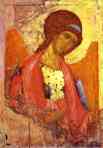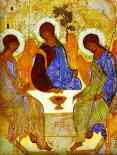Andrei Rublev Biography
Little is known about this pupil of great Byzantine master Theophanes the Greek
, who worked in Rus. Andrei Rublev was most probably born in the Moscow princedom, into the family of an artisan, as the family name comes from the word ‘rubel’ – a tool used in the processing of leathers.
The first mentioning of his name refers to 1405; the document says that for the decoration of the Annunciation Cathedral in Moscow Kremlin there were invited the famous Theophanes the Greek, master Prokhor and monk Andrei Rublev. This means that the painter had already changed the unknown to us name given on birth to the name of Andrei. Historians suppose that Rublev took his vows in the Troitsky (Trinity) monastery under abbot Nikon, pupil and successor of Sergei Radonezhsky. The decorations of the Annunciation Cathedral did not survive the turbulent time, but the Iconostasis still keeps 7 icons by Rublev. They are evidence of his high skills and the following of the Byzantine tradition.
There is the second document, dated 1408, that Andrei Rublev and icon painter Danil (Daniil Tcherny) on May 25 started to decorate the Assumption Cathedral in Vladimir. Those works are the only preserved murals by Andrei Rublev, which show his break/deviation from the Byzantine school, (for differences between the schools read….)
To the 1410s art historians refer the 3 icons in Zvenigorod: Our Savior, Archangel Michael and Apostle Paul. In these icons, especially Our Savior, the new tradition is maturely embodied, marking the beginning of the Golden Age in Russian icon painting.
Probably at that time Rublev painted the Old Testament Trinity, the best of Russian icons. Here he managed to create the mood of spiritual harmony of three souls, the Trinity is an ideal incarnation/embodiment of the complicated theological/divine theme. “The most individual element – and also the most distinctively Russian – is the color scale, which is brighter, more complex, and different in key from that of any Byzantine work. In the hands of a lesser master, such combinations as orange, vermilion, and turquoise might easily have a primitive garishness of the sort we often find in folk art. But here, the controlled intensity of these tones is an essential part of the composition” (History of Art. By H. W. Janson. Fifth Edition. Harry N. Abrams Inc., NY. 1995). Rublev’s Trinity became an example for multiple repetitions and imitations, but none of them reached the same level.
In the middle of the 1420s Rublev and Daniil Tcherny worked on decoration of The Trinity-Sergius Lavra (abbey). The murals have been ruined, only some icons were preserved. The last work of Andrei Rublev – decoration of the Our Savior Cathedral of Spas-Andronnikov monastery in Moscow, where Andrei Rublev lived – were also ruined.
According to the legend Andrei Rublev was a shy and calm person, was busy exclusively with divine service, icon painting and meditation. As all reformers Rublev was often criticized for deviation from the canons; his works were considered to be ‘very joyful’, ‘devoid of fear of the Lord’, ‘lacking splendor’ and much more.
The date of his death, 1430, is the only precise date of his life. He was respected during his life and after his death became a legend, symbol of high spiritual art. However for a long time his authority was based only on the legend, because nobody knew exactly, which works belonged to him for sure, and the most famous of his works, the Trinity, has changed so greatly during time that it's became next to impossible to judge about its merit. Only in the 20th century thanks to works of many researchers and art restorers our understanding and perception of Rublev as one of the geniuses of the world art has been filled with real meaning.
Bibliography
The Trinity by Andrei Rublev. By N. Demina. Moscow. 1963.
Andrei Rublev and His School. By V. Lazarev. Moscow 1966.
Andrei Rublev. By V. Sergeev. Moscow. 1981.
Early Russian Icon Painting. By M. V. Alpatov. Moscow. 1984.
History of Art. By H.W. Janson. Fifth Edition. Harry N. Abrams Inc., NY. 1995
- Our Savior.

1420s. Tempera on wood. 158 x 106 cm. The Tretyakov Gallery, Moscow, Russia.
- Archangel Michael.

1420s. Tempera on wood. 158 x 108 cm. The Tretyakov Gallery, Moscow, Russia. Read Note.
- Apostle Paul.

1420s. Tempera on wood. 160 x 109 cm. The Tretyakov Gallery, Moscow, Russia. Read Note.
- The Old Testament Trinity.

c.1410s. Tempera on wood. 142 x 114 c. The Tretyakov Gallery, Moscow, Russia. Read Note.